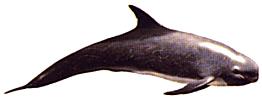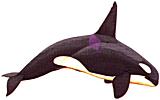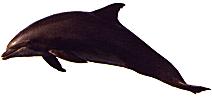|
CETACEAN SURVEY INTRODUCTION In 1998 Assynt Field Club and Ranger Service carried out a cetacean survey for the NW coast of Scotland to tap into the public interest in whales and dolphins and to provide information on their status, distribution and movements. The interest and response was excellent producing 85 sightings of cetaceans that year. All information was passed on to the National Cetacean Sightings scheme. In 2000 H. C. Ranger Service and the Northern Studies Centre carried out a similar survey along the North Caithness and Sutherland coast and the east coast down to Tarbet Ness. A similar method and distributing identification leaflets and recording forms to the local branch of the Scottish Ornithologists Club, East Sutherland Bird Club, ferry operators, offshore oil companies, harbourmaster office, local fishermen, marine rescue team et al. Leaflets were also made available at T.I .O,, libraries, service points, ferry terminal, S.N.H. offices, fishermen’s mission and Scrabster Harbour. Publicity was made through the local press/ and various clubs and societies and Caithness .org the local community web site. Although most of the sightings were casual some were also from watches from set viewpoints. Of the contributors 47 were local 8 were from tourists. 36 record sheets were from land and 21 from boats. The 21 from boats contained proportionally more sightings as they included the ferry operators. Ferry boat operators (John O Groats Ferry to Burwick , Orkney and the P& O Ferry operating form Scrabster to Stromeness) gave us regular sightings throughout their operating time. The John o Groats ferry took part from May to end Sept when the ferry was in operation; the P&O ferry joined in June and carried on throughout the winter so there are gaps in the cover here. The inclusion of the ferries probably leads to a concentration of sightings in the Pentland Firth area. We also had regular surveying from the Golspie /Tarbet Ness area by one recorder giving valuable information on that area. We also had general records from the north coast and from some of the local fisherman but unfortunately not anything specific. A copy of Record sheet and ID leaflet are attached as annex 1. RESULTS We are very pleased with the response to the survey. The number of record sheets returned was 56 and this covered 275 sightings totalling in 1470 cetaceans. Twelve different species were recorded plus basking shark. The majority of those were porpoises at 65% peaking in August with high counts on either side in July and September. This compares with the NW coast survey which peaks in April and May although they also had a small peak in September. The summer months altogether proved fruitful with the highest counts then for minke in July, Aug and Sept.; rissos Sept. and other dolphin species including those unidentified. Of the other whales all 8 orcas were seen in July, August and Sept. and the pilots in July and August. Some of this may reflect calmer weather and people out and about looking although some watches took place in November (Dunnet Bay and Gills Bay) with no returns. Table of species seen per month.
Please note that the figures in the table are for total numbers seen. We have tried to reduce duplication of animals in areas like Gills bay where populations remain for several weeks. The figures in italics are the number of sightings Breakdown of Main Species Seen Porpoise The majority of the species seen were porpoise at 989 animals (162 sightings) which is 61% of all the cetaceans seen. The only month with no sightings was December. The porpoise were seen in small groups most often feeding rather than travelling. Area breakdown Main areas were Pentland Firth, Durness, Strathy Point and Golspie. All apart from Golspie peaked in summer (Durness 35 in July ; Pentland Firth 280-Total- in August). In Gills Bay the build up of small groups of 3-5 lead to figures of 60 with 40 in one sighting in August and high counts of 20-30 in Sept and October. Counts in November returned nothing. We have figures for Gills Bay for the previous year, and there has been a downturn. This is difficult to explain possibly a movement offshore of prey fish . Notes from local fisherman tie the presence of the porpoise in with sand eel presence which peaks in late summer. The returns from Golspie show a double peak one in April (46 Total) one in Sept (30). Rissos Dolphin The total number seen was 37. They were all seen in the months of July, August and September, with 26 out of the total seen in September. Area breakdown; only one animal seen on the east coast off Wick. The highest counts were Gills Bay and John O Groats (5 on 27th Aug and 6+ on Sept 14th). Other high counts were 9-12 --- 18 Sept west off Orkney (Rackwick) and 7- 3rd Sept. Faraid Head. Interesting notes on the Rissos were of them sky pointing in look-out posture in Gills Bay. Minke There were a total of 40 animals seen from the end of May (18th) and the end of Sept (21st). Area breakdown; The highest number were from Durness with regular sightings of 7 throughout Sept. Because there were no specific dates given for the Durness sightings we have included the sighting of 7 only once in the total. Which probably leads to an under estimate. Of the 42 total animals 27 were seen from Melvich west to Durness and 7 down the east coast. In conjunction with the minke sightings were notes of fish jumping and bubbling at the surface of the water (3 notes) and flocks of birds in association. One particularly interesting note was of a minke breaching 74 times on an afternoon crossing of the John O Groats Ferry in early July. The animals seen on the 25, 27 and 28th Aug may have been the same ones. (Melvich, Durness and Sango bay). Orca 8 were seen in July and August. They were seen in the Pentland Firth, Sinclairs Bay and off Lybster where they were described as “huge black and white fish”. The sightings were not definite in two of the records. Pilot Whales; Pilot whales were seen between May and November with singles seen those two months. Of the total of 27 animals 25 were seen in July and August. Area Breakdown; all were seen to the north. On August 12th 12 were seen south of Lother at 11.30pm. and 6-7 see off Claredon head at 5-6pm. Bottlenose dolphins Dolphins were seen in Dunnet bay July 29,30, 31st and Aug 1,2 watched by many and duplicate records have been discounted. Confusion over ID but a study of stills confirms Bottlenose. These cetaceans were watched feeding across Dunnet Bay and then moving west towards Thurso. They were sighted in Thurso bay 31st at 8pm. and a record also came in from Strathy point on the morning of 31st of 20 dolphins. Also of interest were two records of 6-8 dolphins fast moving and in close formation from Huna and Gills bay on the 3rd at 8pm. Possibly these are the same animals. Most of the other records of dolphins came from the east Sutherland coast. White sided dolphin A total of 54 were seen and all in August, September and October. All were seen off the north coast. White beaked dolphin; A total of 14 were seen in May, July and August, All of the north coast. Common dolphin; A total of 8 were seen over the summer between July to October. All from the north coast. The last three species were all seen from boats. Unidentified dolphins There were 10 sightings of unidentified animals amounting to 171 plus animal. A group of 55 seen in May in the Pentland Firth were thought to have been Bottlenose. Three other groups of 6-10 animals were seen swimming quickly on 27th, 28th & 29th of August at Thurso Bay, Pentland Firth and Claredon Head The rarest record by far was of a single sightings of Northern Bottlenose Whale at Brig O Tram off the Wick Coast. The notes provided point to correct ID ; “large and robust looking, very triangular dorsal fin, big bulbous head with prominent beak resting out of the water for about 2 minutes, surfacing every 7-8minutes. The notes were accompanied by sketches. The sighting took place on a clear calm day always the best for whale watching. This record preceded the finding of two animals off Nairn and latterly Findhorn. A Sei Whale was spotted off Smoo cave 1st Sept. Although not supported by photos or notes, sei whales have rarely been recorded off the Caithness and Sutherland Coast. We also had records of 3 basking sharks at Durness. Bias in the report . There is a certain amount of bias in the report which is impossible to over ride. This is caused partly by the location of the ferries who gave us high returns. In addition all the records from the east of Sutherland were from one recorder. Without him it would have looked as if there were no sightings there. His returns would also have been affected by gaps in recording whilst on holiday. These factors point to the limited scientific value of this type of survey. In summary it is clear that the coasts of Caithness and Sutherland are good for cetacean watching particularly in the summer and autumn months. One of the best ways to see them is to take a boat trip or ferry crossing to Orkney. From the returns given to us by the John O Groat`s Ferry and the P & O Ferry then there is a good chance of seeing cetaceans that way. Wildlife tours are also operated from John O Groats and some of the east coast fishermen may take people out to sea. Land based Watches The following places are good; Cape Wrath, Faraid Head, Strathy point, Dunnet Head, Dunnet Bay, Gills Bay, Lybster, Brora, Golspie and Tarbet Ness. Choose a piece of land with an elevated position 15-60 metres above sea level to increase the distance over which viewing is possible. A bay with some protection from the winds and where the water is flatter e.g. Gills bay or the area off Golspie makes sightings easier. Sea watching can be very cold so wrap up well and keep field notes of what is happening, where and when. If you are interested in adding to the information we have on cetaceans then the best way to do this is by taking part in the National Cetacean Sightings scheme. This requires regular 100 minute watches from chosen points using the Seawatch Foundation format. The contact for this is the Seawatch Foundation, 11Jersey Road, Oxford OX44RT. Highland Council Ranger Service would also like to receive any casual sightings in the survey area and copies of the record sheet are still available from Mary Legg , Clett Cottage, Barrock, Caithness.KW148SY We would like to thank everyone who helped with this project particularly the John O Groats Ferry, P&O Ferry and Iain Macdonald from SNH all of whom sent in regular records over the year. Thanks must also go to the funding bodies; Northern Studies, Talisman UK, CASE, SNH and H.C. Ranger Service without whom this survey would not have been possible. Links |



